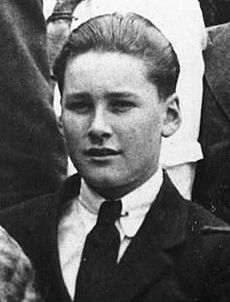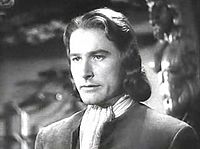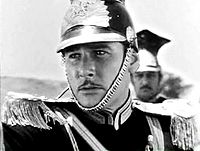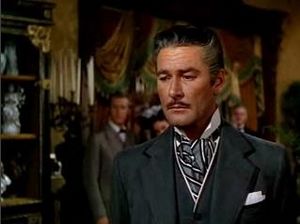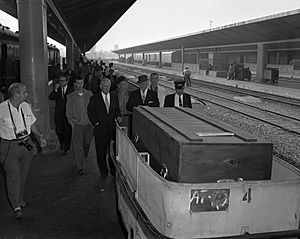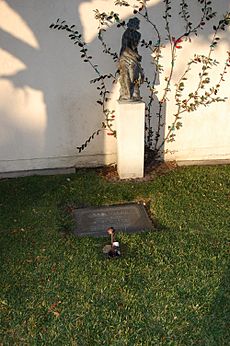Errol Flynn facts for kids
Quick facts for kids
Errol Flynn
|
|
|---|---|
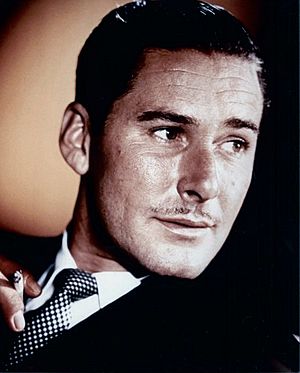
Flynn c. 1940
|
|
| Born |
Errol Leslie Thomson Flynn
20 June 1909 Battery Point, Tasmania, Australia
|
| Died | 14 October 1959 (aged 50) Vancouver, British Columbia, Canada
|
| Resting place | Forest Lawn Memorial Park, Glendale, California, U.S. |
| Nationality |
|
| Occupation | Actor |
| Years active | 1932–1959 |
| Spouse(s) |
Nora Eddington
(m. 1943; div. 1949) |
| Children | 4, including Sean Flynn |
| Parent(s) |
|
Errol Leslie Thomson Flynn (born June 20, 1909 – died October 14, 1959) was a famous actor from Australia and America. He became a worldwide star during the "Golden Age of Hollywood." He was best known for playing brave and romantic heroes in adventure movies.
Some of his most famous roles include the main character in The Adventures of Robin Hood (1938). This role was later named the 18th greatest hero in American film history! He also starred in Captain Blood (1935) and The Charge of the Light Brigade (1936). Errol Flynn also played heroes in many Western movies like Dodge City (1939) and Santa Fe Trail (1940).
Contents
Early Life and School
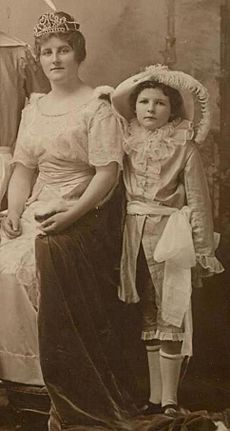
Errol Leslie Thomson Flynn was born on June 20, 1909, in Battery Point, Tasmania, Australia. His father, Theodore Thomson Flynn, was a biology professor at the University of Tasmania. His mother, Marelle, came from a family of sailors. This is likely where Errol got his lifelong love for boats and the sea. Both of his parents were Australian, with roots in Ireland, England, and Scotland.
Errol went to several schools in Hobart, Tasmania, including The Hutchins School and The Friends School. He was known for being a bit mischievous and was expelled from each of them. When he was nine years old, he appeared as a page boy in a special event called a "queen carnival."
From 1923 to 1925, Flynn attended a private boarding school in London, England, called South West London College. In 1926, he returned to Australia and went to Sydney Church of England Grammar School. There, he was classmates with John Gorton, who later became the Prime Minister of Australia.
When he was 18, Errol traveled to Papua New Guinea. He hoped to find his fortune by planting tobacco and mining for gold. He spent about five years going back and forth between New Guinea and Sydney.
Starting His Acting Career
First Movie Role
Australian filmmaker Charles Chauvel was making a movie called In the Wake of the Bounty (1933). It was about the famous Mutiny on the Bounty. Chauvel was looking for an actor to play the role of Fletcher Christian. There are different stories about how Errol Flynn got the part. One story says Chauvel saw his picture in a newspaper article. Another popular story says he was discovered by another actor in the film. The movie was not a huge hit, but it was Errol's first main role. This led him to move to Britain in late 1933 to become a professional actor.
Acting in Britain
In Britain, Errol Flynn first worked as an extra in a movie called I Adore You (1933). Soon after, he joined the Northampton Repertory Company. This was a theater group where he worked and trained as an actor for seven months. Today, there's an art-house cinema in Northampton named the Errol Flynn Filmhouse, which shows how much he was remembered there. He also performed in festivals and in London's West End theater district.
In 1934, a Warner Bros. executive named Irving Asher was impressed by Flynn. Asher cast him in a movie called Murder at Monte Carlo. Even though this movie was not widely seen, Asher was very excited about Flynn's acting. He told Warner Bros. in Hollywood about him, and they offered Errol a contract. So, Flynn moved to Los Angeles to start his Hollywood career.
Hollywood Stardom
On the ship to London, Flynn met actress Lili Damita, who he later married. Her connections were very helpful when he arrived in Los Angeles. Warner Bros. told everyone he was an "Irish leading man from the London stage."
His first roles in Hollywood were small. He appeared in The Case of the Curious Bride (1935) and then had a slightly bigger part in Don't Bet on Blondes (1935).
Captain Blood and Big Successes
Warner Bros. was planning a big adventure movie called Captain Blood (1935). They originally wanted a different actor, but he couldn't do the demanding role. After looking at many actors, Warner Bros. chose Errol Flynn for the main part. He starred opposite 19-year-old Olivia de Havilland.
Captain Blood was a huge success! It made Errol Flynn and Olivia de Havilland into big Hollywood stars. They became a popular on-screen team, making eight movies together over six years. The movie earned a lot of money for Warner Bros.
Because Captain Blood was so popular, Warner Bros. quickly put Flynn and de Havilland together again. They starred in another adventure movie, The Charge of the Light Brigade (1936). This film was even more successful than Captain Blood and was Warner Bros.' biggest hit of 1936.
Flynn wanted to try different types of roles. He got a lead role in Green Light (1937), where he played a doctor. But the studio soon put him back into adventure movies, like The Prince and the Pauper (1937). He also wrote his first book, Beam Ends (1937), about his sailing adventures as a young man. In 1937, he traveled to Spain to report on the Spanish Civil War.
The Adventures of Robin Hood
Next, Errol Flynn made his most famous movie, The Adventures of Robin Hood (1938). He played the main role, with Olivia de Havilland as Maid Marian. This movie was a huge success all over the world. It was one of the top-grossing movies of 1938. It was also Warner Bros.' first big movie made using the new three-strip Technicolor process, which made the colors look amazing.
Robin Hood cost a lot to make, but it earned much more money back and was a huge profit for the studio. Critics loved it, and it became a favorite movie for many people around the world.
Even after the success of Robin Hood, Warner Bros. still wanted Flynn to mostly make adventure films. However, he did get to try a dramatic role in The Dawn Patrol (1938).
In 1939, Flynn and de Havilland teamed up again for Dodge City (1939). This was their first Western movie. Flynn was worried that people wouldn't like him in Westerns, but the film was Warner Bros.' most popular movie of 1939. After this, he made many more successful Westerns.
World War II and Later Career
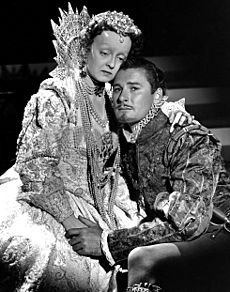
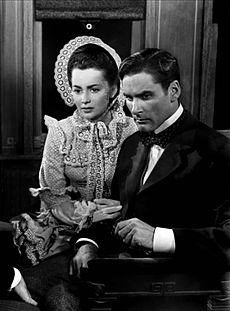
Errol Flynn was one of Warner Bros.' biggest stars. In 1937, he was even ranked as their number one star.
He became an American citizen on August 14, 1942. When the United States entered World War II, he tried to join the military. However, he could not pass the physical exam due to health issues. Because of this, some reporters and critics made fun of him. But the studio did not want to admit that their athletic star had health problems.
Flynn started working often with director Raoul Walsh. They made They Died with Their Boots On (1942), a movie about George Armstrong Custer. This was the last of eight films he made with Olivia de Havilland. It was a very big hit for Warner Bros.
His first World War II movie was Desperate Journey (1942), where he played an Australian for the first time. This was also a big success.
One of Flynn's favorite roles was playing the boxer Gentleman Jim Corbett in Walsh's Gentleman Jim (1942). Warner Bros. bought the rights to make the movie just for him. Flynn trained a lot for this film and did many of his own boxing scenes. The movie was very popular and earned a lot of money.
In Edge of Darkness (1943), Flynn played a Norwegian resistance fighter during World War II. This movie was also a big success for Warner Bros.
After the War
In 1946, Flynn published an adventure novel called Showdown. He then starred in Cry Wolf (1947), a thriller. Another popular film was the Western Silver River (1948).
Warner Bros. tried to put Flynn back into swashbuckler roles with Adventures of Don Juan (1948). This movie was very popular in Europe, but less so in the U.S. After this, Warner Bros. started making Flynn's movies with smaller budgets. In 1947, he signed a new 15-year contract with Warner Bros.
Later Warner Bros. Films
After a small appearance in It's a Great Feeling (1949), Flynn made a movie for another studio, Metro-Goldwyn-Mayer, called That Forsyte Woman (1949). This movie was a big hit. He then made two Westerns for Warner Bros., Montana (1950) and Rocky Mountain (1950), both of which were popular.
He returned to MGM for Kim (1950), which was one of his most popular movies from this time. It was filmed partly in India. Flynn also wrote and helped produce a low-budget film called Adventures of Captain Fabian (1951).
In 1952, Flynn was very sick with hepatitis, which caused damage to his liver. He made another adventure film for Warner Bros. in England, The Master of Ballantrae (1953). After this movie, Warner Bros. ended their contract with him after 18 years and 35 films.
Working in Europe
Flynn then moved his acting career to Europe. He made an adventure movie in Italy called Crossed Swords (1954). He tried to produce his own movie, The Story of William Tell (1953), but it ran into problems and caused him financial difficulties. To earn money, he took roles in British films like Lilacs in the Spring (1954) and The Dark Avenger (1955). In 1956, he hosted a TV show called The Errol Flynn Theatre.
Return to Hollywood
After five years, Flynn received an offer to make a Hollywood film again: Istanbul (1957). He also made a thriller in Cuba, The Big Boodle (1957). He then had a very good role in the popular movie The Sun Also Rises (1957). His acting in this film was praised, and it led to more roles where he played characters struggling with life.
Warner Bros. cast him as famous actor John Barrymore in Too Much, Too Soon (1958). He also appeared in The Roots of Heaven (1958). In late 1958, Flynn went to Cuba to film a movie he produced called Cuban Rebel Girls. While there, he met Fidel Castro and supported the Cuban Revolution. He even wrote newspaper articles about his time in Cuba with Castro. His last known work was a short film called Cuban Story: The Truth About Fidel Castro Revolution (1959).
Personal Life
Marriages and Family

Errol Flynn was married three times. His first wife was actress Lili Damita, from 1935 to 1942. They had one son, Sean Flynn. His second wife was Nora Eddington, from 1943 to 1949. They had two daughters, Deirdre and Rory. His third wife was actress Patrice Wymore, from 1950 until his death. They had one daughter, Arnella Roma. Errol is the grandfather of actor Sean Flynn, who starred in the TV show Zoey 101.
After leaving Hollywood, Flynn lived with his wife Patrice Wymore in Port Antonio, Jamaica. He helped develop tourism in that area. He even owned a hotel for a while and made bamboo raft trips down rivers popular.
His only son, Sean (born in 1941), became an actor and war reporter. Sean and his friend disappeared in Cambodia in April 1970 during the Vietnam War. They were working as photojournalists for Time magazine. After a long search, Sean was officially declared dead in 1984.
Death
By 1959, Errol Flynn was having serious money problems. On October 9, he flew to Vancouver, British Columbia, Canada. He went there to arrange the lease of his yacht, Zaca, to a businessman. On October 14, as the businessman was driving Flynn to the airport, Flynn started complaining of severe pain.
He was taken to a doctor's home. The doctor gave him medicine and advised him to rest. After about 20 minutes, Flynn was found unresponsive. Despite immediate medical help, he did not wake up and was pronounced dead that evening. The official report said he died from a heart attack. His parents were still alive when he passed away.
Errol Flynn was buried at Forest Lawn Memorial Park Cemetery in Glendale, California. He once said he disliked this place. It is said that six bottles of his favorite whiskey were buried with him.
Filmography
Select Radio Performances
Flynn appeared in many radio shows:
| Year | Title | Venue | Dates performed |
|---|---|---|---|
| 1937 | Captain Blood | Lux Radio Theatre | February 22 |
| 1937 | British Agent | Lux Radio Theatre | June 7 |
| 1937 | These Three | Lux Radio Theatre | December 6 |
| 1938 | Green Light | Lux Radio Theatre | January 31 |
| 1939 | The Perfect Specimen | Lux Radio Theatre | January 2 |
| 1939 | Lives of a Bengal Lancer | Lux Radio Theatre | April 10 |
| 1940 | Trade Winds | Lux Radio Theatre | March 4 |
| 1941 | Virginia City | Lux Radio Theatre | May 26 |
| 1941 | They Died With Their Boots On | Cavalcade of America | November 17 |
| 1944 | Command Performance | Armed Forces Radio Network | July 30 |
| 1946 | Gentleman Jim | Theatre of Romance | February 5 |
| 1952 | Kim | Lux Radio Theatre | February 18 |
| 1952 | The Modern Adventures of Casanova | Mutual radio series | 39 episodes |
Theatre Performances
Flynn performed on stage many times, especially early in his career:
- The Thirteenth Chair – December 1933 – Northampton Rep
- Jack and the Beanstalk – December 1933 – Northampton Rep
- Sweet Lavender – January 1934 – Northampton Rep
- Bulldog Drummond – January 1934 – Northampton Rep
- A Doll's House – January 1934 – Northampton Rep
- On the Spot – January 1934 – Northampton Rep
- Pygmalion – January–February 1934 – Northampton Rep
- Crime at Blossoms – February 1934 – Northampton Rep
- Yellow Sands – February 1934 – Northampton Rep
- The Grain of Mustard Seed – February 1934 – Northampton Rep
- Seven Keys to Baldpate – March 1934 – Northampton Rep
- Othello – March 1934 – Northampton Rep
- The Green Bay Tree – March 1934 – Northampton Rep
- The Fake – March 1934 – Northampton Rep
- The Farmer's Wife – March–April 1934 – Northampton Rep
- The Wind and the Rain – April 1934 – Northampton Rep
- Sheppey – April 1934 – Northampton Rep
- The Soul of Nicholas Snyders – April 1934 – Northampton Rep
- The Devil's Disciple – May 1934 – Northampton Rep
- Conflict – May 1934 – Northampton Rep
- Paddy the Next Best Thing – May 1934 – Northampton Rep
- 9:45 – May–June 1934 – Northampton Rep
- Malvern festival – July–August 1934 – appeared in A Man's House, History of Dr Faustus, Marvelous History of Saint Bernard, The Moon in Yellow River, Mutiny
- A Man's House – August – September1934 – Glasgow, St Martin's Lane
- Master of Thornfield – February 1958 – adaptation of Jane Eyre
Images for kids
-
With Olivia de Havilland in The Adventures of Robin Hood (1938)
-
With Bette Davis in The Private Lives of Elizabeth and Essex (1939)
-
With Olivia de Havilland in Santa Fe Trail (1940)
See also
 In Spanish: Errol Flynn para niños
In Spanish: Errol Flynn para niños


